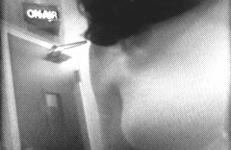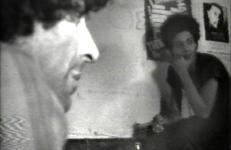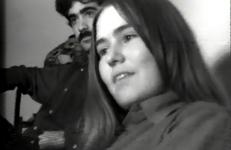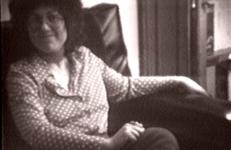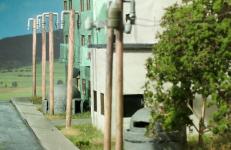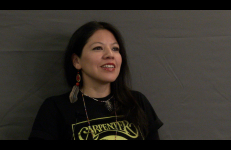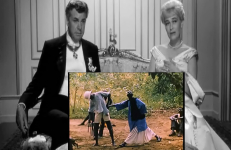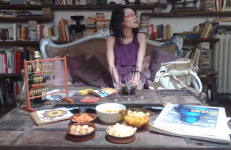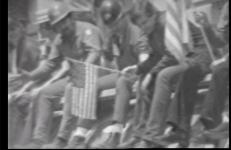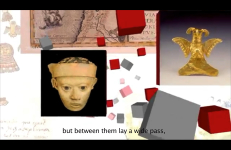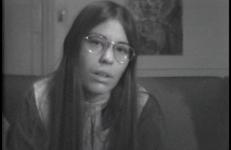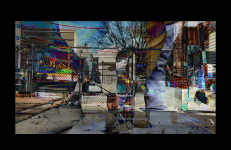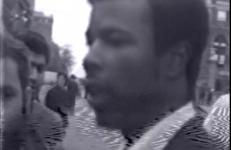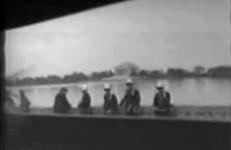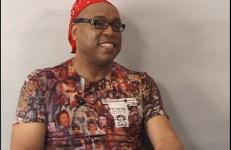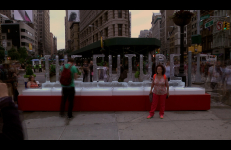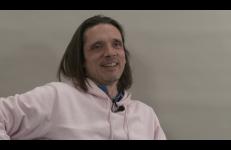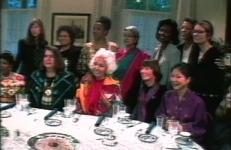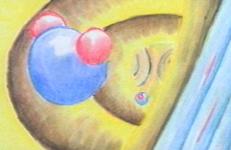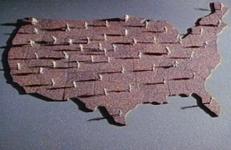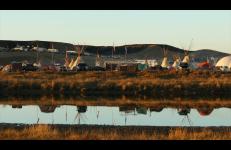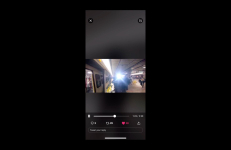The Videofreex had several experiences with the Black Panther Party, including interviewing Illinois Chapter Deputy Chairman Fred Hampton and New Haven Minister of Information Cappy Pinderhughes. In this tape, recorded on March 5th 1971, the Videofreex one-person camera crew Bart Friedman is walking the hallways of CBS, trying to find out where a video statement by Black Panther Eldridge Cleaver is located. The shots are mostly close up on people’s torsos and there is some image loss, but the sound is intact. The tape has an eerie espionage feel.
Activism
Shot in October 1969, this tape gives an inside view of the workings of late-sixties radical groups and the debates going on within their ranks. At a meeting of Yippies, there is a discussion about the nuts and bolts of fundraising through benefit concerts and events in an attempt to finance support efforts related to the Chicago 8 Conspiracy Trial.
An interview with a group of people shot in October 1969, some of whom were involved in The Weathermen’s "Days of Rage" actions. As those present recount the significance of the actions, and the possible ramifications on the movement as a whole, some critics voice serious complaints.
Judy Chicago (b.1939) creates large-scale, collaborative artwork has brought greater prominence to feminist themes and craft arts such as needlework and ceramics. Her most famous work, The Dinner Party (1979), was an enormous collaboration with hundreds of volunteers including ceramicists, china painters and needleworkers. The monumental finished piece has place settings for 39 mythical and historical famous women, writing them back into the heroic history usually reserved for men. Earlier in her career, Chicago was part of the Finish Fetish movement within Minimalism.
Little Radek, the step-dancing Bolshevik; Machera, the Andean Robin Hood, and Maria Spiridonova, the Russian socialist assassin are your guides for Past Leftist Life Regression therapy. In this third Inner Trotsky Child video, narrator Lois Severin— a former Trotskyite turned suburban housewife—attempts to radicalize the personal fulfillment and self-help scene.
Colectivo Los Ingrávidos (Tehuacán) is a Mexican film collective founded in 2012 to dismantle the commercial and corporate audiovisual grammar and its embedded ideology. The collective is inspired by the historical avant-gardes, and their commitment to using both form and content against alienating realities. Their methods combine digital and analog mediums, interventions on archival materials, mythology, agitprop, social protests, and documentary poetry.
Resisting the regime of the counter-shot, this experimental short fiction film follows the story of Alex on the eve of Le Pen’s defeat in the 2002 French presidential election. A well-meaning American writer, they must face a bombastic inner voice before it ruins a friend’s act of eco-terrorism and the relationship with girlfriend Oona.
Though this video segment bears the title Construction Workers Rally, much more than issues of labor are addressed. On May 8th of 1970, approximately two hundred demonstrating construction workers, mobilized by the New York State AFL-CIO, had attacked 1,000 high school and college students and others protesting the Kent State shootings, the American invasion of Cambodia, and the Vietnam War.
Here, a double morphology of conversion forces us to think about the trance of non-reconciliation, outburst and trance that go through the centuries of colonial violence until reaching us in the tension of an audiovisual disjunction: visible and enunciable. On the one hand the museum, habitat of barbarism, on the other hand the voice, place and body of the furious testimonial. Religious conversion that conveys communal violence. Archaeological conversion that imposes object immobility.
In conversation with Carol Vontobel (behind the camera) and Nancy Cain, Curtis (Mary Curtis) Ratcliff describes getting her first legal abortion, soon after the state of New York legalized the procedure in 1970. Curtis supplies details of the cost of abortions at the Women’s Medical Center in New York City versus clinics such as Planned Parenthood, as well as a play-by-play account of her experience at the Center, describing the efforts of a counselor, the doctor’s demeanor, and demographics of the women using the Center’s services.
These are the ghosts of a haunted civilization, a culture of progress that hides the social and political horror behind the streets. These are the haunted figures in the Capitalocene era. A sinister dance of macabre abstraction. A scanner darkly of the streets. Part of the Hauntology series.
Though difficult at times to understand what is happening due to audio damage, this tape provides rich historical documentation of a protest on Wall Street in May of 1971. The tape also records the energy in the air created by motivated activists who took to the streets at Columbia University in protest of the Vietnam War.
—Faye Gleisser
Footage from the May Day 1971 events in Washington DC. Davidson, a Videofreex member, gets arrested, and what follows is rarely seen footage of the inside of the detainment bus and the jail cell, videotaped by an arrestee.
In this interview, American artist, independent curator, writer, and experimental filmmaker, Vaginal Davis reflects on her initiation into the punk rock and art scenes of Los Angeles during the 1980s and 90s, her stylistic influences, and her ongoing efforts to theorize queerness and visuality. Caught between the opposing poles of Hollywood classicism and the rawness of punk, Davis defines her unapologetically gender-bending, campy, and at times aggressively critical performances as scenarios, rather than spectacles or entertainment.
On September 21, 2014 Ligorano Reese installed a 3,500 pound ice sculpture of the words The Future at the intersection of Fifth Avenue and 23 Street in New York during the People's Climate March. This video compresses the 11 hour event into 4 minutes.
“A century's carelessness is now melting away the world's storehouses of ice, a melting whose momentum may be nearing the irreversible. It's as if we were stripping the spectrum of a color or eradicating one note from every octave.”
–Bill McKibben, January 2006
Turner Prize winning conceptual artist Jeremy Deller works across many different mediums, creating highly political and frequently collaborative works. Defying conventionality, Deller often exhibits outside of traditional gallery spaces, such as his 1993 twist on artist open studios, Open Bedroom, a secret exhibition in Deller’s family home while his parents were on holiday.
Executive produced by Sara Diamond at the Banff Art Centre, co-produced by Michelle Baughn and Suzanne Lacy, directed by Tom Weinberg and Dick Carter, and edited by Holen Kahn.
The first of the series includes:
What Does Away Mean? by Jem Cohen advertises the need to recycle through reconsideration of landfills and garbage disposal.
Pro-Choice is Pro-Life by Jane Pratt makes its point with the simple logic that every child should be cared for and wanted.
Historic Preservation by Jim McKay counsels for the preservation of historic buildings endangered by urban decay.
This video collects public service announcements created by a number of independent producers, including Jem Cohen and Michael Stipe of R.E.M. Powerful and provocative, these PSAs address issues such as organic farming, abortion rights, street harassment, and the environment. Included are:
They Have Dreams by Natalie Merchant and Abigail Simon which focuses on the plight of homeless children.
The third compilation in this series of progressive, creative public service announcements for under-reported issues. Featuring various styles and formats, from street photography to optical printing, from edgy black and white film to hand-drawn animation, the seven spots in this latest installment are:
The Breathing Tree by Eric Darnell and Doug Loveid, an animated easy-to-understand explanation of how forests contribute to life by producing oxygen.
An incomplete and imperfect portrait of reflections from Standing Rock. Cleo Keahna recounts his experiences entering, being at, and leaving the camp and the difficulties and the reluctance in looking back with a clear and critical eye. Terry Running Wild describes what his camp is like, and what he hopes it will become.
D.A.R.E. (Drug Abuse Resistance Education) is a hyper-war waged on over 20 million children in the United States. Despite overwhelming evidence of its educational ineffectiveness, D.A.R.E. has gained a religious following among educators and parents, and is the only federally-funded drug education program. D.A.R.E.'s imagistic and psychological assault is based on the presence of uniformed gun-toting police officers in the classroom.
D.A.R.E. (Drug Abuse Resistance Education) is a hyper-war waged on over 20 million children in the United States. Despite overwhelming evidence of its educational ineffectiveness, D.A.R.E. has gained a religious following among educators and parents, and is the only federally-funded drug education program. D.A.R.E.'s imagistic and psychological assault is based on the presence of uniformed gun-toting police officers in the classroom.
Do Not Circulate, an experimental short film, attempts a structuralist and materialist approach to unraveling the entrails of a collective media memory. Paced by an essay as a relentless voiceover, the film rips footage that challenges the materiality, ownership and legal boundaries of documentation.




